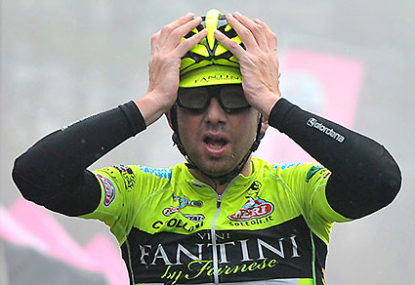'I've just won a stage of the Tour de France, mate!': Hindley grabs yellow jersey as Aussie blows Tour apart
Australia's Jai Hindley has said he is "lost for words" after a shock stage victory at the Tour de France earned him the leader's…

As cycling fans we’re never too surprised when a rider tests positive but the three adverse results for Danilo Di Luca, Mauro Santambrogio and Sylvain Georges from the 2013 Giro d’Italia cut me a little deeper than I might have expected.
In Di Luca’s case it wasn’t so much that result that hurt, after all, at 37 he’s one of the ‘bad old-boys’ with a history of doping.
Santambrogio’s and Georges’ failed test irked me partly because at 28, they’re two of the younger riders and we’re being consistently told that cycling is a much cleaner sport these days.
So I have to say the jury remains out on that claim.
But the key word there is partly, because my gripe is not so much with the riders but with the UCI and WADA, because of the management of the drug testing protocols.
Di Luca tested positive on April 29, just two days after he returned to racing. Santambrogio tested positive after the first stage on May 4. Georges tested positive after the seventh stage on May 10.
Of course, testing rider samples is an exact process and must be carried out in WADA accredited labs using a very stringent process.
But this protocol isn’t without its critics and none of them are bigger than former WADA President Dick Pound.
Pound, now International Olympic Committee Chairman, was recently in a working party that put together a report for the WADA Executive ahead of November’s World Conference on Doping In Sport.
It was titled the ‘Lack of Effectiveness of Testing Programs’ and its 27 pages identified many weaknesses with the WADA testing regime.
Here’s a section of the report.
“The primary reason for the apparent lack of success of the testing programs does not lie with the science involved.
“While there may well be some drugs or combinations of drugs and methods of which the anti-doping community is unaware, the science now available is both robust and reliable.
“The real problems are the human and political factors. There is no general appetite to undertake the effort and expense of a successful effort to deliver doping-free sport.
“This applies (with varying degrees) at the level of athletes, international sport organisations, national Olympic committees, NADOs and governments.
“It is reflected in low standards of compliance measurement (often postponed), unwillingness to undertake critical analysis of the necessary requirements, unwillingness to follow-up on suspicions and information, unwillingness to share available information and unwillingness to commit the necessary informed intelligence, effective actions and other resources to the fight against doping in sport.”
So plenty to think about, but for me one crucial matter was not mentioned.
That being the time it takes to analyse and determine the status of a test.
I accept this will vary depending on what drug is being tested for but in the case of our three Giro riders why did it take so long for the results to be released?
Di Luca failed his test on April 29, but had raced 18 stages of the Giro before the UCI announced the positive result on May 19.
By then of course he’d had four top ten stage finishes.
Santambrogio was tested after Stage 7 on May 10 with the UCI announcing the finding on June 3 but in the meantime he’d won Stage 14.
Georges was also tested after Stage 7 but he withdrew before Stage 11 and was notified on May 21.
How much better would things have been if the results were processed much more quickly?
We would have enjoyed cleaner racing and different results, with (at the very least) Nibali claiming honours on stage 14 instead of second place.
At the London Olympics, the Organising Committee (LOCOG) organised for a giant WADA accredited testing lab to be built in Essex. One of its objectives was to process tests as quickly as possible.
Most tests would be processed within 24-48 hours but it may take up to 72 hours to test for drugs like EPO.
Three days is still a long time but it sure is better than two or three weeks!
Even adding the time to transport the samples to a WADA accredited testing facility, there’s no reason a test result for EPO can’t be announced well inside 96 hours.
If WADA can manage it for the Olympics they can do it for cycling. What is there to lose?
It may be that faster test turnarounds won’t stop riders from doping but it will remove them from the action a lot more quickly, and anything that rids us of watching cheats has to be a good thing.